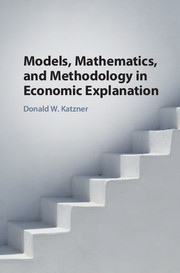Book contents
- Frontmatter
- Dedication
- Contents
- Preface
- Introduction
- 1 Science and Economics
- 2 Economic Models and Explanation
- 3 The Stages of Model Building in Economics
- 4 Models and Mathematics
- 5 Models and Measurement (or Lack Thereof)
- 6 Issues Relating to the Construction of Models from Scratch
- 7 An Example: The Efficiency of Organizational Forms
- 8 The Implicit Assumption Requirements of Later-Stage Model Building
- 9 Ordinality and the Adequacy of Analytic Specification
- 10 Categories of Models
- 11 Conclusion
- Index
5 - Models and Measurement (or Lack Thereof)
Published online by Cambridge University Press: 26 October 2017
- Frontmatter
- Dedication
- Contents
- Preface
- Introduction
- 1 Science and Economics
- 2 Economic Models and Explanation
- 3 The Stages of Model Building in Economics
- 4 Models and Mathematics
- 5 Models and Measurement (or Lack Thereof)
- 6 Issues Relating to the Construction of Models from Scratch
- 7 An Example: The Efficiency of Organizational Forms
- 8 The Implicit Assumption Requirements of Later-Stage Model Building
- 9 Ordinality and the Adequacy of Analytic Specification
- 10 Categories of Models
- 11 Conclusion
- Index
Summary
For present purposes, measurement may be regarded as the assignment of numbers to non-numerical manifestations or instances of a property of objects. Thus, as an illustration, various unquantified “longnesses” of specific articles are measured as their quantified length. The assignment of numbers to such manifestations is called a scale. Different categories of scales or measures preserve and reflect different kinds of information concerning relationships among the various manifestations of the property. The four main measure types are (i) nominal measures which only give a unique numerical name to each manifestation and contain no further information; (ii) ordinal measures that are nominal measures reflecting certain ordering relations among the manifestations; (iii) interval or cardinal measures that are ordinal measures such that the numerical value of combinations of manifestations is the sum of the numerical values of the manifestations that are combined; and (iv) ratio measures that are cardinal measures having the same meaning for the zero value regardless of the particular scale employed.
It should be noted that since the numerical values of a variable that is only ordinallymeasured reflect nothing more than the underlying ordering relation defined among the possibly unmeasured manifestations to which those numerical values relate, the numerical values themselves have no content and significance other than that present in the underlying ordering relation. This means that upon applying any continuous, increasing transformation4 to a collection of ordinal, numerical, variable values results in a new set of ordinal, numerical, variable values that contains the same information as the old collection, and that one set of ordinal, numerical values is as good as any other. That is, the selection of one such collection of ordinal variable values is arbitrary. In the case of a cardinally measured variable, only positive linear transformations (ax+b, where x is the variable and a > 0 and b⋛0 are real constants) are admissible because only those transformations preserve the meaning of the sum of variable values in terms of the combination of underlying manifestations. And with ratio measured variables, the positive linear transformations must be such that b = 0 in order to maintain the fixity of the zero-variable-value position.
The differences between nominal, ordinal, cardinal, and ratio scales can be illustrated by considering certain characteristics implied by their definitions. Think of two pieces of wood whose longnesses are measured in terms of inches.
- Type
- Chapter
- Information
- Models, Mathematics, and Methodology in Economic Explanation , pp. 101 - 124Publisher: Cambridge University PressPrint publication year: 2017



